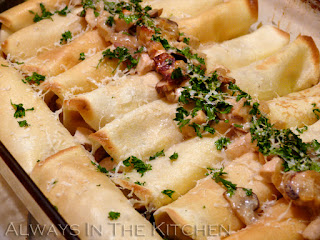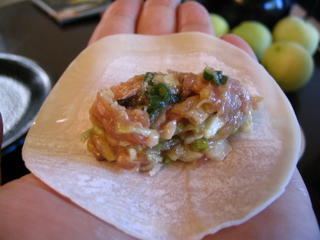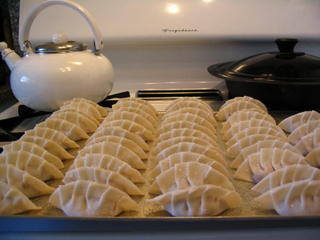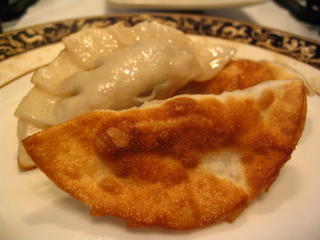
I've been making crêpes fairly often since we moved to Germany. They're a wonderful, multi-purpose flatbread that you can make in advance, even refrigerating for a few days (or freezing...separate each one with parchment, and bag them up) so that you can have them on hand for quick breakfast, lunch, snacks, hors d'oeuvres, dinner, or dessert. It's all about what you fill them with, and how many of them you want to eat at a time, that determines their role.
I have posted a recipe for Crêpes before, showcasing one of the wonderfully tender and silky French styles of crêpe. I still make those (they are especially good as dessert crêpes, with a sweet filling), but I also have another, slightly less eggy-and-rich go-to recipe for an everyday crêpe that can be used in exactly the same way.
These crêpes are the ones you want to use if you want the emphasis to be on the filling slightly more than the crêpe itself (don't worry, they're still delicious!), if you want a slightly lower fat/calorie version, or if you go to make crêpes and discover that you only have two eggs on hand. If you are planning breakfast crêpes with an egg filling, you probably want to use this recipe rather than the other.
The ratios are from Cook This Not That! but with better (I think) mixing directions.
You can easily halve the batch, or double it, as you see fit.
Everyday Crêpes
Makes 10-12 6-inch crêpes
1 cup unbleached all-purpose flour
pinch of salt
2 large eggs
3/4 cup milk
1/2 cup water
1-2 tablespoons melted butter
In a medium mixing bowl (or food processor, or blender), mix the flour and salt. Separately, combine the eggs, milk, and water, and beat well. Add the liquid mixture to the flour, and whisk (or process with a cutting blade) until smooth.
If you are mixing by hand and cannot get rid of a few lumps, simply pour the batter through a sieve, and push-through or discard any lumps left behind.
Stir in the melted butter, and then let the batter rest for about 15 minutes so that the flour fully hydrates. If you're planning to fill the crêpes right away, you might want to get your filling(s) ready while the batter rests. Otherwise, just pour yourself a glass of something pleasant - might I suggest wine? - to sip at during the cooking process.
To make a six-inch (15 cm) crêpe, I use an eight-inch (20 cm) non-stick skillet. The skillet is usually measured by the width of the top of the pan, but the base is usually somewhat smaller. The base of my skillet is just over 6 inches. You can use whatever size skillet you like, for whatever size crêpes you like, but I find this to be the best all-purpose crêpe size.
Just like in the previous recipe:
Heat the skillet over medium heat until a drop of water dances. Spritz with canola oil, or brush very lightly with mild oil of your choice. You only need to do this for the first crêpe, if you're using a non-stick pan.
Using a ladle or scoop that holds 3 tablespoons, measure your first crêpe's worth of batter. Lift the skillet off of the heat (I hold it in the air) and quickly pour the batter into the middle of the pan. Drop the ladle back into the batter-bowl and rapidly tilt the skillet in a circular motion, to spread the batter until it evenly covers the base of the pan. Return the pan to the burner, and allow the crepe to cook until lightly golden, and the edges release from the pan, about a minute or two.
Slide a silicone spatula under the crêpe (or grab the edge carefully with your fingers) and flip it over. Let it continue to cook for a minute, and then slide the crêpe onto your work surface for filling.
Repeat until all of the crêpe batter has been cooked. This does take a little bit of time, unless you've got multiple skillets going and are multi-tasking like a champ, which is (well, one reason) why I suggest having a beverage on hand to sip while you cook.
The crêpes in the bento above have a filling of Tilsit cheese (you could substitute Havarti), very thinly sliced ham, and chopped toasted walnuts. I find that it's important when considering crêpe fillings to ensure that there is something that will act as a sort of "glue" to keep the filling together while you're eating. A filling of only dry items, such as dice chicken, chopped almonds, and asparagus will simply fall apart into its discrete components once you cut into it. A small amount of cheese, or scrambled egg, or thick sauce (or paste) of any kind will help keep the filling together.
The other compartment of the bento above has a Greek-ish salad chopped cucumber, bell pepper, tomato, feta, radishes and an oregano lemon dressing, and the little dark item is a miniature Chocolate Oatmeal Peanut Butter Chip muffin, as a tiny little dessert.




































